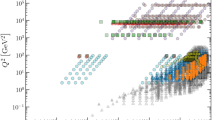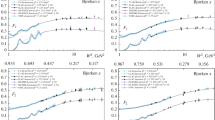Abstract.
The discovery more than twenty years ago, by the EMC Collaboration, that the deep-inelastic-scattering DIS structure functions are influenced by the nuclear environment stunned the nuclear physics community and brought quarks and gluons into the field with great impact. A great length of time has passed, but despite a semi-infinite number of papers on the subject, there is no explanation that is universally accepted. Many models (related in one way or another to QCD) have been successful in reproducing data for deep inelastic scattering on nuclear targets, but fewer have described both the DIS and nuclear Drell-Yan experiments. Although there are some positive indications, no model has been used to predict correctly and unambiguously new independent phenomena. We review the history and discuss the best experimental prospects for future discovery.
Similar content being viewed by others
References
J. Aubert, Phys. Lett. B 123, 275 (1982)
For example, see the reviews: M. Arneodo, Phys. Rep. 240, 301 (1994)
L.L. Frankfurt, M.I. Strikman, Phys. Rep. 160, 235 (1988).
J.W. Chen, W. Detmold, Phys. Lett. B 625, 165 (2005).
G.A. Miller, J.R. Smith, Phys. Rev. C 65, 015211 (2002)
J.R. Smith, G.A. Miller, Phys. Rev. C 65, 055206 (2002).
R.P. Bickerstaff, M.C. Birse, G.A. Miller, Phys. Rev. Lett. 53, 2532 (1984)
D.M. Alde, Phys. Rev. Lett. 64, 2479 (1990).
G.F. Bertsch, L. Frankfurt, M. Strikman, Science 259, 773 (1993).
P.A.M. Guichon, Phys. Lett. B 200, 235 (1988)
I.C. Cloet, W. Bentz, A.W. Thomas, Phys. Rev. Lett. 95, 052302 (2005).
D. Diakonov, V.Y. Petrov, arXiv:hep-ph/0009006.
J.R. Smith, G.A. Miller, Phys. Rev. Lett. 91, 212301 (2003)
L.L. Frankfurt, M.I. Strikman, Nucl. Phys. B 250, 143 (1985).
M.R. Frank, B.K. Jennings, G.A. Miller, Phys. Rev. C 54, 920 (1996).
J.W. Negele, Nucl. Phys. Proc. Suppl. 73, 92 (1999).
S. Strauch, Phys. Rev. Lett. 91, 052301 (2003).
R. Schiavilla, O. Benhar, A. Kievsky, L.E. Marcucci, M. Viviani, Phys. Rev. Lett. 94, 072303 (2005).
F. Schlumpf, hep-ph/9211255.
G.A. Miller, M.R. Frank, Phys. Rev. C 65, 065205 (2002)
O. Gayou, Phys. Rev. Lett. 88, 092301 (2002).
G.A. Miller, Phys. Rev. C 68, 022201 (2003)
Author information
Authors and Affiliations
Corresponding author
Rights and permissions
About this article
Cite this article
Miller, G.A. Implications of the nuclear EMC effect. Eur. Phys. J. A 31, 578–584 (2007). https://doi.org/10.1140/epja/i2006-10258-6
Received:
Accepted:
Published:
Issue Date:
DOI: https://doi.org/10.1140/epja/i2006-10258-6




